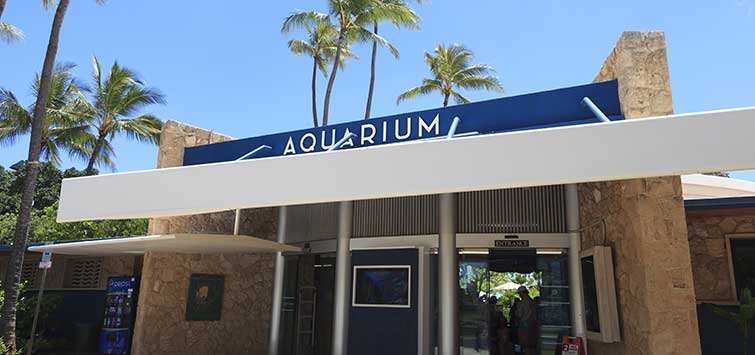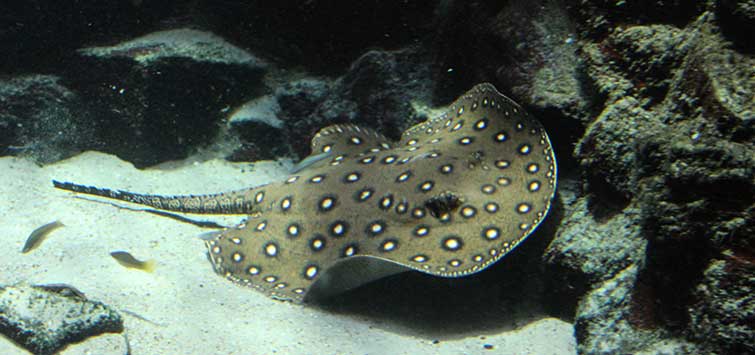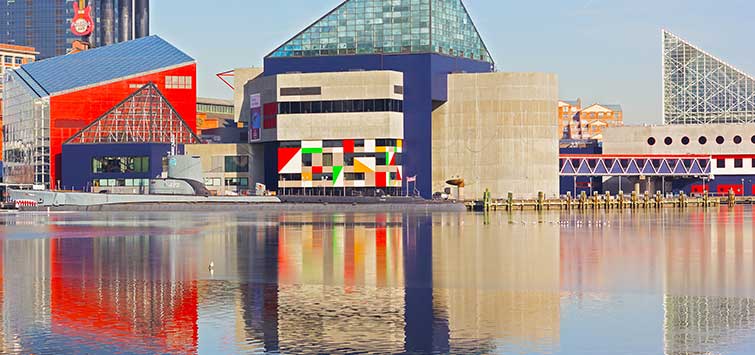Honolulu's Waikiki Aquarium
Author: Iggy Tavares, PhD
Waikiki Aquarium, one of the oldest public aquaria, is not only a grand showcase of marine life but also a venerable institution noted for its aquatic research.
In Blue Hawai‘i
Hawai‘i looked so idyllic in Elvis Presley’s 1961 film Blue Hawaii and the television series Hawaii Five-O that it was always my dream to visit one day. I finally made the marathon journey from London, UK to Honolulu, O‘ahu, via San Francisco in July 2010. On my list of things to do was visit marine hobbyists around Honolulu, do some snorkeling in the famous Hanauma, and visit the Waikiki Aquarium.
The Waikiki Aquarium, which started life as the Honolulu Aquarium, is one of the oldest public aquariums in the United States, having first opened in 1904. It is located in Kapi‘olani Park on Kalākaua Avenue, within walking distance of most of the hotels. The current Waikiki Aquarium building, which opened in 1955, is small when compared to modern developments such as the Georgia Aquarium or even the Monterey Bay Aquarium. However, the Waikiki Aquarium has a good selection of variously sized displays with many fish found around Hawai‘i that I had not seen before.
The aquarium’s first exhibit is an interactive display of corals that examines their diversity and shows that they are live animals. Viewing of this and the other aquarium exhibits is facilitated by an audio wand that provides a description of the exhibit along with some interesting facts about the fish and habitat. Near the entrance, the SeaVision Theatre presents videos about Hawai‘ian marine communities and ocean habitats, as well as conservation, fisheries, and aquaculture. Then come the four main galleries: the South Pacific Marine Communities, Hawai‘ian Marine Communities, Diversity and Adaptation, and Fisheries and Conservation.
South Pacific Marine Communities Gallery
The South Pacific Marine Communities gallery included several exhibits of different sizes. I rather enjoyed the Land Meets Sea display. Filled with mangroves and sea grass, it housed a mixed and varied community of fish able to withstand the ever-changing brackish water conditions. These included monos Monodactylus argenteus and archerfish Toxotes jaculatrix, as well as Bangaii cardinalfish Pterapogon kauderni that were mouthbrooding, and much more.
Reef Partners Exhibit
The Reef Partners exhibit, which highlighted the relationships found on a reef—such as that of a clownfish and sea anemone—also had a beautiful Hawai‘ian filefish Pervagor spilosoma and some unusual-looking Pacific trumpetfish Aulostomus chinensis. The Groupers and Snappers exhibit housed a large polka-dot grouper Cromileptes altivelis and a colorful sailfin snapper Symphorichthys spilurus among large predators.
The large, colorful, 5500-gallon Barrier Reef display was teeming with over a hundred different species of fish. Several giant clams that started here as dime-sized hatchlings in 1982 have grown in 30 years to huge 170-pound monsters. The clams and large, colorful coral heads form the perfect backdrop for the multitude of fish that inhabit the reefs in this display, from surgeonfish such as Naso vlamingii and Acanthurus pyroferus to blue triggerfish Odonus niger and singular bannerfish Heniochus singularius.
Also included were some angelfish and butterflyfish, which seemed to be doing well, as well as a host of smaller fish and some larger ones such as harlequin sweetlips Plectorhinchus chaetodonoides, making for a colorful spectacle. Additionally, there were interactive touchscreens that helped identify and provide some information on every species in the exhibit. These seemed to be very popular.
Hawai‘ian Marine Communities Gallery
The Hawai‘ian Marine Communities gallery featured several midsized display aquariums that depict the different habitats around the islands. The Koko Head surge zone exhibit featured powerful pumps that created a turbulent mix of bubbles and water, while the Kāne‘ohe Bay display presented a sheltered reef containing delicate branching corals and plate corals.
Kona Coast Young Reef Display
The Kona Coast young reef display had some nice fish, such as the longnose butterflyfish Forcipiger flavissimus. My favorite, however, was the Lāna‘i Deep Reef display, which housed the rarely seen and typically expensive masked angelfish Genicanthus personatus. The display also included Japanese angelfish Centropyge interruptus and slingjaw wrasse Epibulus insidiator, along with a variety of others.
Hunters of the Reef Exhibit
The largest display was the Hunters of the Reef exhibit, a floor-to-ceiling 35,000-gallon tank. This display is very popular with the visiting public, particularly children, as it holds blacktip sharks, stingrays, jacks, and groupers, which are common predators on Hawai‘ian reefs. Giant groupers stayed still in the water and watched visitors while sharks swam around their large tank singly and jacks grouped together in small schools.
A seating area let visitors take in the view from a short distance, and a spyball camera allowed close-up viewing of the sharks on a television screen. Colorful lighted panels around this exhibit introduced visitors to shark research, biology, conservation, and safety.
Diversity and Adaptation Gallery
The Diversity and Adaptation gallery featured fish and other creatures that use deception, venom, and/or armor to protect themselves or capture their prey. The Ambush Predators exhibit presented a stunningly beautiful red painted frogfish Antennarius pictus in one display, and a dragon moray eel Enchelycore pardalis and other eels poked their heads out from among the rocks in another. The Kaleidoscope Sea and Miniature marine life displays also featured here.
Fisheries and Conservation Gallery
Fisheries and Conservation gallery featured the Marine Protected Areas, which had a nice selection of fish that included a crosshatch trigger Xanthichthys mento, stareye parrotfish Calotomus carolinus, Moorish idol Zanclus cornutus, Hawai‘ian damselfish Dascyllus albisella, convict surgeonfish Acanthurus chronixis, and raccoon butterflyfish Chaetodon lunula.
The adjoining large tank held four of the strange-looking, rare, bearded armorheads Evistias acutirostris, a species I had never seen before. A small aquarium held Centropyge abei, another rare dwarf angelfish gem from the Hawai‘ian deep. The other half of the gallery was dedicated to freshwater concepts, covering Native Stream Life, Responsible Fishkeeping, Food Gone Wild, and Ornamental Aquaculture. Other exhibits in this gallery were the 1000-gallon moon jellyfish tank, as well as exhibits with jet-propelled nautilus, color-changing squid, and a lively octopus.
Outdoor Exhibits
The outdoor 7500-gallon, 24-year-old Edge of the Reef exhibit gave me a chance to catch sight of two more typically Hawai‘ian fish that inspire off the scratched-glass viewing windows. The Hawai‘ian triggerfish Rhinecanthus aculeatus, which is the unofficial state fish of Hawai‘i, was bold enough to come to the viewing window while several large ringtail surgeonfish Acanthurus blochii swam around the exhibit.
This exhibit was teeming with fish, some of which I did see while snorkeling in Hanauma. These included yellow tangs, convict tangs, pufferfish, various wrasses such as blacktail wrasse Thalassoma ballieui, snappers, angelfish, damsels, and others. The touch pool and petting area was very popular with the children, allowing them to handle crabs, sea urchins, sea shells, and more.
Hawai‘ian Monk Seal Exhibit
I was surprised to discover the Hawai‘ian Monk Seal exhibit, which featured a couple of these endangered seals. They were rescued as pups and raised at the aquarium. Their daily show, performed at their outside pool, is very popular with visitors, particularly children. One gets a chance to learn more about the seals as they perform a few tricks and are rewarded with food fish.
Ocean Culture Exhibit
The Ocean Culture exhibit featured the Pacific six-fingered threadfin that used to be raised in Hawai‘ian fish ponds as food. Research on active breeding and reintroduction programs are currently being investigated. The aquarium also has active coral and giant-clam farming facilities that utilize bright sunlight for their growth. A large outside aquarium neighboring it was filled with beautiful green Acropora and giant clams alongside several mature yellow tangs, a large angelfish, and a couple of the rare black tang, making for a stunning display and a nice way to finish the Waikiki Aquarium tour.
Northwestern Hawai‘ian Islands Exhibit
Waikiki Aquarium has been undergoing renovation and replacement over the years. Work has started on the latest project, the Northwestern Hawai‘ian Islands exhibit, which will feature a living reef ecosystem representative of that found around Hawai‘i’s isolated islands where some 2000 endemic marine species are found.
Visit the Waikiki Aquarium
I enjoyed my visit to the Waikiki Aquarium and its many specialized galleries, which provided many enjoyable views of the several fish species found around Hawai‘i. The galleries and features may be modest compared to some of today’s new developments, but this old aquarium has won many awards for its research and conservation efforts, some of which is done in cooperation with the University Hawai‘i. The Waikiki Aquarium was such a delightful experience that I ended up making a second visit.
See the full article on TFH Digital http://www.tfhdigital.com/tfh/201106#pg99

.png?h=595&iar=0&w=2781&hash=5FD5E69473BCC22199FBFA2FB71B6033)



